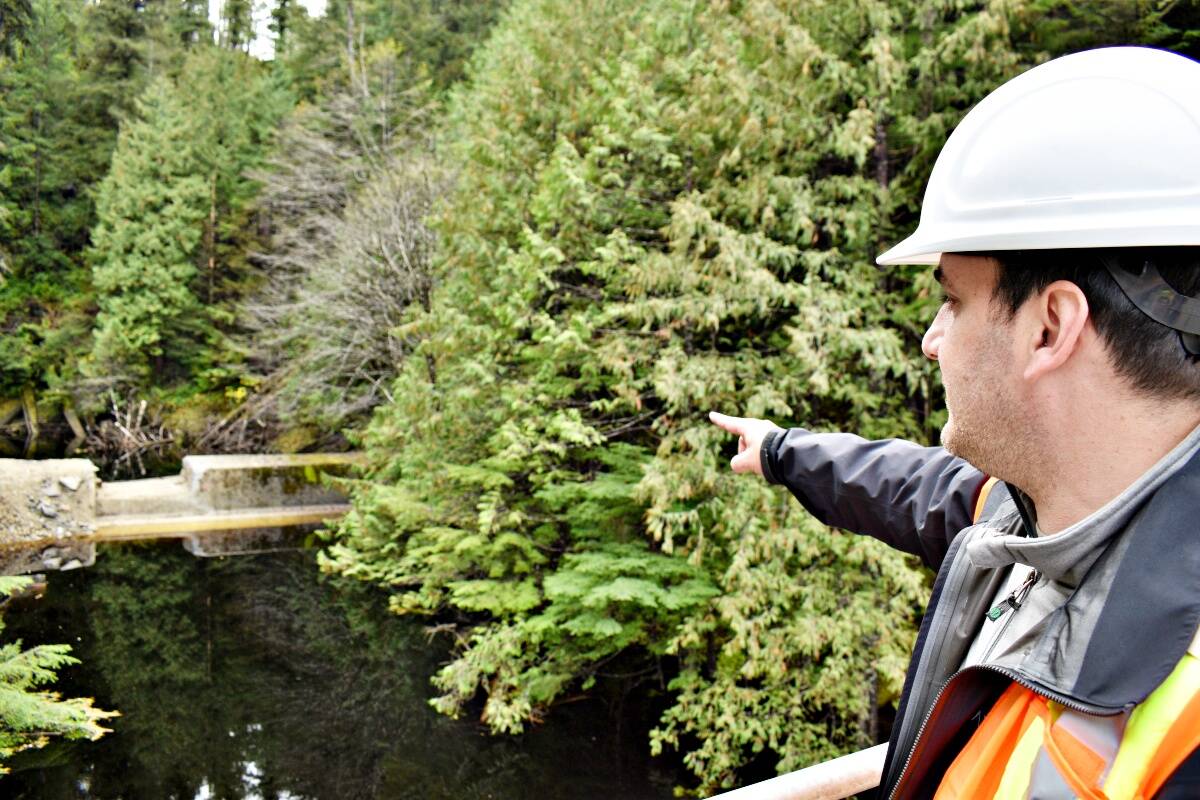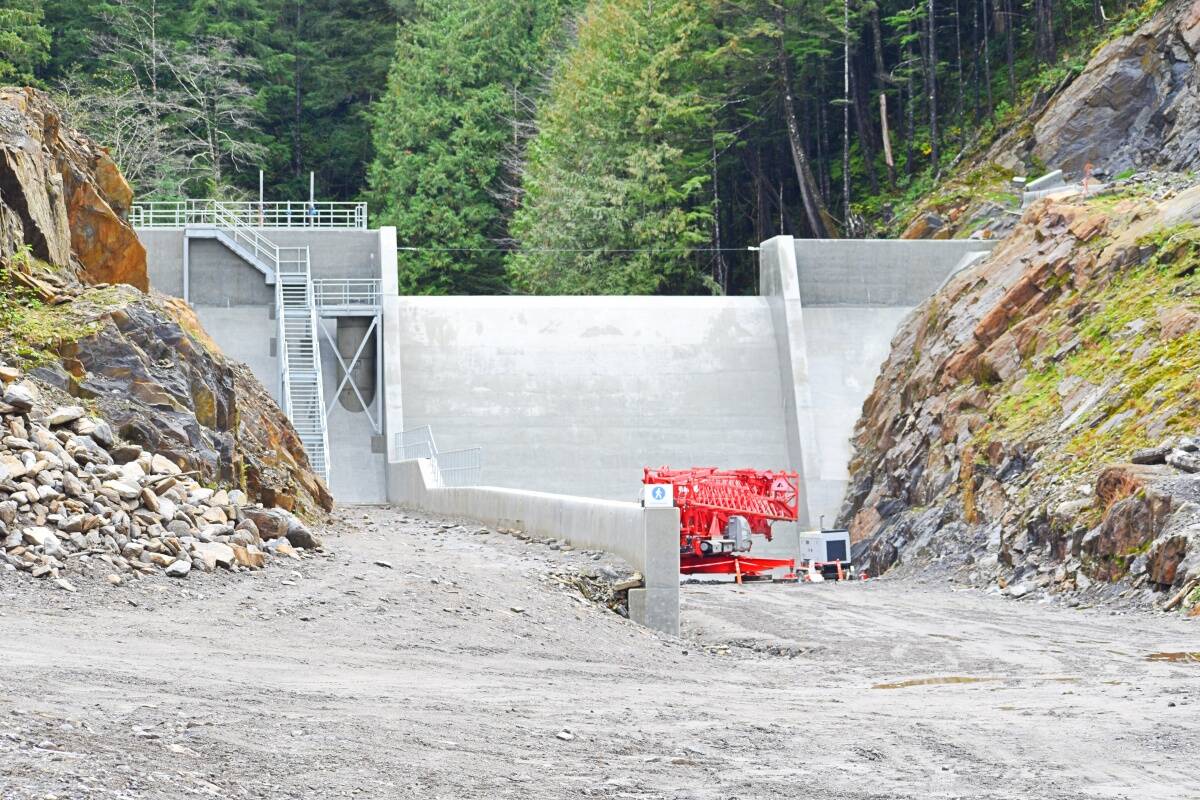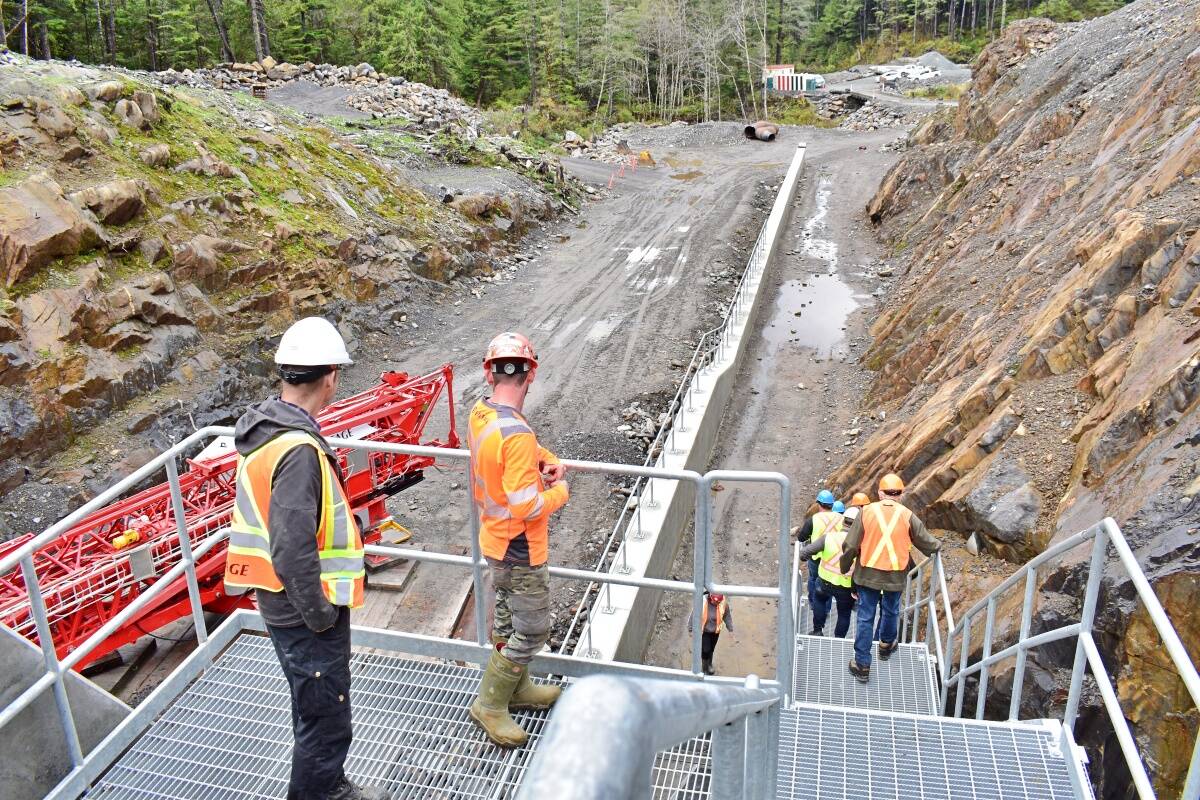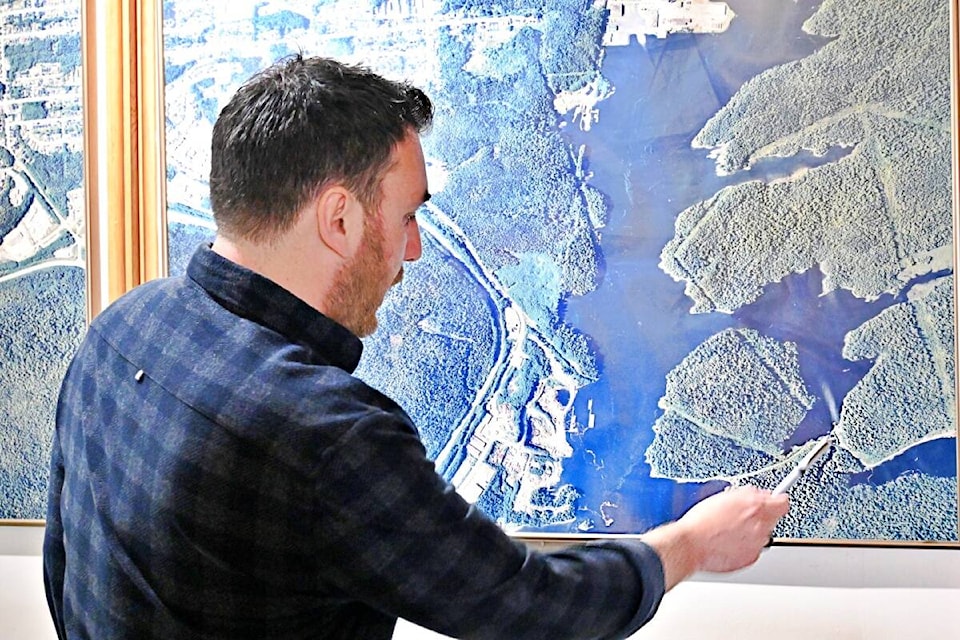Special feature written for The Northern View PROGRESS Edition
The supply of clean and fresh drinking water flowing through our taps isn’t a concern that usually crosses the minds of many Canadians today; after all, it is 2023. However, for the past decade, the necessity of the natural resource has been a growing concern for the residents of Prince Rupert and the municipal corporation that manages it.
For more than 100 years, Woodworth Lake and dam have fed the water supply for different purposes to the city of Prince Rupert. On Feb. 8, the results of an eight-year and just less than $24 million water security project were finally tasted by relieved city dwellers. They were carried into the modern day with municipal leaders looking and planning toward the next 100 years. They closed the door on the past century of development, a boom and bust situation with some financial regress.
By all accounts, Prince Rupert grew and thrived from its incorporation as a new municipality on March 10, 1910, into a railroad, fishing and pulp mill town. As the population grew to the current 12,000, so did the amenities and bank balances of many. People enjoyed life living for the here and now. Infrastructure was built, roads were constructed, an entertainment center was built, a recreation centre was built, library, swimming pool, ice rink, the list goes on. It is even understood that the city was so wealthy that heated sidewalks were installed at one point. Money was spent as quickly as it was earned.
While money was being spent on the present, no thought was being given to the future - no provision was made to maintain those heated streets, let alone provide the necessity of clean drinking water, maintain infrastructure or supply vital services.
Only 80 years after incorporating, the fishing industry tanked, the mill closed and the city was broke after years of extravagance. Prince Rupert was on the verge of bankruptcy. There was simply no money to fix the dilapidating house the community took shelter under.
In 2014, after years in a municipal downward spiral, the voters claimed the victory of change with a young 29-year-old mayor, Lee Brain and a new council at the helm of the sinking ship.
The challenges of healing the broken bones of aging and neglected infrastructure and finding ways to increase income to do so were ones the newbies raised their swords to battle.
Brain told The Northern View in October 2022 that rebuilding the city from the inside out was daunting, but the dam replacement was the first priority and one he wanted to make his legacy. Rebuilding was not an overnight task and Brain knew from day one of taking office it would take years and millions of dollars the city didn’t have to complete the necessities.
Since 2016 the city has been pumping from its secondary water supply source Shwatalans Lake, with increasing health risks, water notices and boil advisories due to the lower water levels of the lake and increased turbidity.
The Northern View sat down with Prince Rupert City Operations Manager Richard Pucci who is the “go to” for the know on the invisible infrastructure issues that residents don’t see on a daily basis or until a problem arises.
To explain the journey the city had to take to reach the stage of the new Woodworth Dam construction, which was finally completed in October 2022, Pucci provided some background and history, so the whole picture of what city hall staff and council undertook is in myopic focus.
The City of Prince Rupert’s water source didn’t start off from the current Woodworth Lake and dam like many believe, he said.
“People think that we started getting our water from there in 1918 — that’s not the truth. So, back in the early days of Prince Rupert, the water was actually from ‘on island’. The original dam was a timber dam on Mount Hays.”
This dam was in use until it was decommissioned in the early 1950s or 60s, Pucci said, when the primary water source was transferred to Shwatalans Lake.
It wasn’t until 1975-76 that the city purchased the old Woodworth Dam site from BC Hydro. The dam is a “rock mass dam” explained as a structure built with boulders and rock filled in with a “slurry of concrete.” Its construction was started in 1914 and continued until 1918 when it was first used as a hydroelectric dam by Northern Power.
After the city purchased the Woodworth Dam, Woodworth Lake became the residents’ primary source of drinking water. The dam was refurbished in the mid-1980s for safety purposes and lowered by two metres. The power generation equipment was removed and the “penstock” or the raw water supply lines, were connected to the Woodworth water source.
“Then that was our life - that became our primary water source until we started the replacement of it.”
The dam replacement project started more than seven years ago after cracks in the structure were spotted before that. It hasn’t been an easy voyage to the completed new dam with clean water as the project has had to overcome access, supply and construction challenges.
Before any construction could start, a road needed to be built.
“The remoteness of that site has really been our Achilles heel since we started on that source. Over the years, we tried to get better access to it. But just the terrain is so rugged … it’s just been, one of those things where we had to really fight to get up there.”
Access was a mission Pucci explained, with a long hike, sometimes two to three times a week for contractors and staff. A typical winter inspection would start with a boat ride from Seal Cove across the water to Sunshine Bay, where maintenance technicians would hop in a truck and drive the 15-minute, eight-kilometre windy stretch to a landing area. All-terrain vehicles (ATV) were necessary for another 20 mins. ride where people would dismount and trek for a further 30 mins.
“With the winter we have had this year, it would be a complete hike in for about four and half hours,” Pucci said.
“[Just anecdotally] whenever we’d go on an inspection, we’d take a chainsaw with us because typically, I would say, seven out of 10 times you’re cutting a tree that has fallen over the road or over the trail.”
Pucci said while the dam is a vital piece of infrastructure, one element of the project they are most proud of is the Belgium steel pipe replacement of the raw supply lines, the old above-ground penstock from 1914, some of which was still wood stave pipe.
“That is really what gained us all the access in the road … up there. We did that in 2017 to 2018. At the time, it was a revolutionary project for us because it actually [enabled] access to do the replacement of the dam. There’s no way we could have done it without that road.”
“The road was arguably one of the most important pieces because it brings access to the dam.”
The construction of the road was the first part of the three-phase water construction project, with the actual dam construction as Phase 2 and water treatment as Phase 3, which has just started, Pucci said.
Once the road was completed, it wasn’t all smooth travelling. Several setbacks created delays during the project, which extended the anticipated completion timeline.
Extreme weather and two one-in-100-year flood events occurred, washing out bridge abutments, as well as landslides which needed to be cleared
“We couldn’t operate or do any work during the events. Then after, there was a ton of cleanup,” he said, detailing that trees were constantly down and debris would cause hazards to the road and people working.
“When that happens, you have to stop all work. You can’t just be going in and out.”
Another hurdle that required leaping over was the supply chain issues when the global pandemic hit. There were delays on steel. Work had to shut down completely at one point and to overcome that, work fronts were moved to keep some momentum. But time inefficiencies were still experienced, Pucci said.
The operations manager started working at the city 16 years ago. He said cracks in the dam and issues were noted a few years later.
The city was looking at the project in 2014-15 he said, with grants applications starting in 2015.
“We saw the performance of the dam in our inspections showing some slight deterioration. There was still performance left in the dam, but we knew that we didn’t have a long time left with it.”
The newly elected Mayor Brain and council were extremely supportive, Pucci said.
“So we said, listen, this is something as a municipality, we need to do. We need to secure a potable water source … we are going to set our priorities around security of water and the treatment of water. That was a conscious decision of mayor, council and staff’s objectives.”
However, the city had no money and was almost bankrupt.
The municipality started its campaign with the province for support and was successful with the provincial government liking the three-phase approach it had presented, Pucci said.
The dam project was partly funded by the Canadian Water and Wastewater Fund (CWWF), with the Federal government dedicating $4,295,000, the Province $2,834,700, and the remainder covered by the city through dividends from Prince Rupert Legacy Inc. and borrowing.
“We are actually now two-thirds of the way through the program, which is amazing and during which was arguably some of the worst times we’ve seen. We still maintained our objectives.”
The dam construction started with a request for proposal (RFP) in 2018 where contractors could submit designs and bids. Dam building is very specific and precise. There are only a few select companies who can complete the task, he said.
The first contractor hired was L&M Engineering who took the role of the owner’s engineer during the work.
Pucci said the city was very selective of the people they would be working with.
“We wanted to make sure that this piece of infrastructure was put in by someone who knows what they’re doing and has a reputation of doing dams and has the experience.”
Pucci said a lot of the construction was overseen by the owner’s representative and city employee Hans Seidemann who worked closely with L&M and other contractors such as CIC for earthworks, Eiffage, BBA Design team, among many other hands who assisted.
“That’s why we build a team so that you have an owner’s representative that can be there and make sure that our best interests are valued during the whole process.”
While conceptual designs had been discussed, it took a few months for the final design to be completed. During the design process, some site-specific issues needed to be addressed and added like rock profile and consistency, but the overall end result was fairly close to the initial concept, Pucci explained.
“Then we went into civil works. The concept or the idea for the dam was to build a new structure about 30 metres in front of the old existing structure.”
This enabled the existing structure to be used as a coffer dam so the water reservoir levels could be lowered and not flow over, allowing for crews to work in the dry. Once the new dam was complete, the old dam would have sections removed to permit water flow.
The Woodworth Dam site is located in a provincial watershed conservancy, so the new structure needs permits and is allowed to be only a certain height. The city decided to raise the height to that of the old dam before it was lowered in the 1980s.
“The reason why we did that was for climate change modelling … We were looking at climate change, we’re looking at population increase in the community and then also the ability to generate small amounts of power up there for lights, cameras and any other small things that need to be done.”
While the construction of the new dam was completed in October 2022, it took a few months for the reservoir to fill, so water could flow to city residents. The old dam is now in an equilibrium state underwater and acts as a filter of sorts to catch sediments. A supplemental bypass has been installed next to the dam for times when the water levels are too low to allow a gravity feed.
Habitat biologists were consulted and the creekbed has been re-established with rocks, boulders and riparian areas. Pucci said there is per second per litre flow requirement that is maintained and supplemented by the bypass.
After greasing the pipes and water quality testing, the taps were turned on with the City of Prince Rupert announcing to residents on Feb. 8, that they were able to taste and use Woodworth water again for the first time in several years. Water advisories and boil notices were hopefully a thing of the past.
“The results have been great. We’ve actually had some of the best water we’ve seen in 20 years,” Pucci said. “It’s been a very good transition.”
For the entirety of the four-year-plus construction, the city has been pumping water from Shwatalans Lake at a cost of $15,000 per month, Pucci lamented.
“We’re able to save that and go back to gravity, which is virtually a free system. We’re very lucky to have the gravity system. A lot of communities don’t.”
Current city Mayor Herb Pond said in February, this final return of the city to its original water supply marks the end of one of the biggest infrastructure endeavours the city has seen in recent history.
“This project was no small undertaking, and it’s a credit to the former mayor and council, as well as staff, that we were able to see it through, despite challenges along the way.”
Previous city councillor Blair Mirau who was one of the newbies in 2014, is proud of the accomplishment of keeping city residents supplied with clean drinking water.
“This incredibly complex once-in-a-generation project took nearly eight years to the day from when council identified its replacement as a number one priority until Prince Rupert finally returned to our primary water supply. Prince Rupert’s old water dam lasted over 100 years. This new dam will take our community’s water supply into the next century.”
“Between the multiple landslides that blocked the construction crews, boil water advisories, the pandemic, and all the supply chain issues that followed, this project certainly saw its fair share of setbacks. So it’s refreshing to raise a glass to celebrate the accomplishment of securing fresh water for the next generation of Prince Rupert,” Mirau said.



